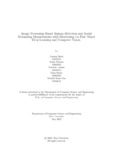| dc.contributor.advisor | Chakrabarty, Amitabha | |
| dc.contributor.author | Datta, Anurag | |
| dc.contributor.author | Fatema, Kaniz | |
| dc.contributor.author | Tasnim, Nowshin | |
| dc.contributor.author | Sitara, Faria | |
| dc.contributor.author | Das, Mrithik Kanti | |
| dc.date.accessioned | 2022-09-27T06:11:29Z | |
| dc.date.available | 2022-09-27T06:11:29Z | |
| dc.date.copyright | 2022 | |
| dc.date.issued | 2022-05 | |
| dc.identifier.other | ID 18101369 | |
| dc.identifier.other | ID 19201132 | |
| dc.identifier.other | ID 19101655 | |
| dc.identifier.other | ID 18101295 | |
| dc.identifier.other | ID 17101047 | |
| dc.identifier.uri | http://hdl.handle.net/10361/17345 | |
| dc.description | This thesis is submitted in partial fulfillment of the requirements for the degree of Bachelor of Science in Computer Science and Engineering, 2022. | en_US |
| dc.description | Cataloged from PDF version of thesis. | |
| dc.description | Includes bibliographical references (pages 46-51). | |
| dc.description.abstract | The COVID-19 pandemic has significantly affected day to day lifestyle all over the
planet by disequilibrating social order. It moreover added anxiety about the capability
of the world’s democracies to cope with the vital and crucial emergencies.
We should urgently restore a necessary methodology to fathom the emergency and
rigorously depict a course forward. The Division of Public Health authorities have
recommended everyone to uphold social distancing with a view to diminishing the
number of physical encounters. To keep a record of social distancing from an overhead
standpoint, we established a computer vision deep learning framework. Our
schemed system utilized the object recognition paradigm to spot and identify people
in video sequences or frames.
In our research, we assess the classification performance of two distinct multilayer
neural network models named YOLO using OpenCV and TensorFlow which are used
in the implementation process of an automatic recognition system. Amongst these
using SSD, CUDA, and CUDNN we achieved a success rate in the classification.
Neural networks were trained on a dataset where we used COCO dataset methods.
At a time when neural networks are increasingly being utilized for a spectrum of
uses, it is essential to select the proper model for the classification process that
can attain the ultimate accuracy with the least amount of training duration. The
demonstration created by us allows the insertion of images and the creation of their
datasets, this allows the user to train a model using their chosen parameters. The
models can then be saved and used in other systems. Moreover, to prevent future
crucial situations and by keeping in the head about COVID affected situations on
various global aspects this work will become an integral part of contributing to the
term “Social Distancing” by implementing this sustainably and with one of the best
results outcomes in our proposed image processing based human detection and social
distancing measurements with monitoring via fine tuned deep learning and computer
vision. Because coronavirus sickness has had such a negative influence on the world
economy, this research tries to reduce the further impacts while minimizing resource
loss. Also, create a very accurate detection mechanism to aid in the tracking of
social distancing. In these types of serious situations, adequate actions must be
taken and help to assist further research and work as an example for future works
on this segment. | en_US |
| dc.description.statementofresponsibility | Anurag Datta | |
| dc.description.statementofresponsibility | Kaniz Fatema | |
| dc.description.statementofresponsibility | Nowshin Tasnim | |
| dc.description.statementofresponsibility | Faria Sitara | |
| dc.description.statementofresponsibility | Mrithik Kanti Das | |
| dc.format.extent | 51 pages | |
| dc.language.iso | en | en_US |
| dc.publisher | Brac University | en_US |
| dc.rights | Brac University theses are protected by copyright. They may be viewed from this source for any purpose, but reproduction or distribution in any format is prohibited without written permission. | |
| dc.subject | Human detection | en_US |
| dc.subject | Social distancing | en_US |
| dc.subject | YOLO algorithm | en_US |
| dc.subject | Image processing | en_US |
| dc.subject | Deep learning | en_US |
| dc.subject | TensorFlow | en_US |
| dc.subject | Computer vision | en_US |
| dc.subject | MobileNet SSD | en_US |
| dc.subject.lcsh | Image processing -- Digital techniques. | |
| dc.subject.lcsh | Cognitive learning theory (Deep learning) | |
| dc.subject.lcsh | Machine learning | |
| dc.subject.lcsh | Human-machine systems | |
| dc.title | Image processing based human detection and social distancing measurements with monitoring via fine tuned deep learning and computer vision | en_US |
| dc.type | Thesis | en_US |
| dc.contributor.department | Department of Computer Science and Engineering, Brac University | |
| dc.description.degree | B. Computer Science and Engineering | |

